Caracterización fisicoquímica y evaluación de la actividad antioxidante de propóleos recolectados en el departamento del Atlántico, Colombia
Physicochemical characterization and evaluation of antioxidant activity of propolis collected in the Atlántic department, Colombia
Contenido principal del artículo
Resumen
Se realizó una comparación de las propiedades fisicoquímicas de los propóleos recolectados en los municipios de Galapa, Sabanalarga, Santo Tomás y Juan de Acosta, del departamento del Atlántico (Colombia). Adicionalmente, se estableció la actividad antioxidante in vitro de los extractos etanólicos de propóleos (EEP), mediante las técnicas de DPPH, ABTS, FRAP y ORAC. El análisis fisicoquímico de los propóleos mostró valores de 8,48 - 24,21%, 1,77 - 6,07%, 55,57 - 77,93%, 5,74 - 11,69% y 0,35 - 3,86%, para el EEP, ceras, insolubles, humedad y cenizas, respectivamente. La determinación para los fenoles totales, se encuentra entre 63,72 y 94,55mg, de ácido gálico/g de muestra. Las absorbancias específicas de los EEP estuvieron dentro del rango de 26 a 96 y el contenido de flavonoides totales mostró valores entre 1,90 y 3,36mg, de quercetina/g de muestra. De los extractos, el que presentó mayor capacidad antioxidante fue el propóleos, recolectado en el municipio de Galapa, con los siguientes valores DPPH: 190,41 TEAC (μmol/g), ABTS: 1918,41 TEAC (μmol/g) y FRAP: 321,27 AEAC (μmol/g) y el segundo valor más alto en ORAC (1964,80 μmol Trolox/g de propóleos). Los resultados obtenidos indican que los propóleos estudiados presentaron variación en las propiedades fisicoquímicas. Los valores de algunos de los parámetros fisicoquímicos estimados no cumplieron con las normativas de calidad establecidas internacionalmente; no obstante, los extractos etanólicos de propóleos evaluados presentaron un alto contenido de fenoles, los cuales, están relacionados con las propiedades antioxidantes encontradas experimentalmente.
Palabras clave:
Descargas
Datos de publicación
Perfil evaluadores/as N/D
Declaraciones de autoría
- Sociedad académica
- Universidad de Ciencias Aplicadas UDCA
- Editorial
- Universidad de Ciencias Aplicadas y Ambientales U.D.C.A
Detalles del artículo
Referencias (VER)
AHN, M.R.; KUMAZAWA, S.; HAMASAKA, T.; BANG, K.; NAKAYAMA, T. 2004. Antioxidant Activity and Constituents of Propolis Collected in Various Areas of Korea. J. Agric. Food Chem. 52(24):7286-7292.
AHN, M.R.; KUMAZAWA, S.; USUI, Y.; NAKAMURA, J.; MATSUKA, M.; ZHU, F.; NAKAYAMA, T. 2007. Antioxidant activity and constituents of propolis collected in various areas of China. Food Chem. 101(4):1383- 1392.
AUBAD, P.; ROJANO, B.; LOBO, T. 2007. Actividad antioxidante en musgos. Scientia Et Technica. 13(33):23-26.
BANKOVA, V. 2005a. Recent trends and important developments in propolis research. eCAM. 2(1):29-32.
BANKOVA, V. 2005b. Chemical diversity of propolis and the problem of standardization. J. Ethnopharmacol. 100(1-2):114-117.
BANKOVA, V.; CASTRO, S.; MARCUCCI, M. 2000. Propolis: Recent advances in chemistry and plant origin. Apidologie. 31(1):3-15.
BANSKOTA, A.; TEZUKA, Y.; ADNYANA, I.; ISHII, E.; MIDORIKAWA, K.; MATSUSHIGE, K.; KADOTA, S. 2001. Hepatoprotective and anti-Helicobacter pylori activities of constituents from Brazilian propolis. Phytomedicine. 8(1):16-23.
BENZIE, I.; STRAIN J. 1996. The ferric reducing ability of plasma (FRAP) as a measure of "antioxidant power": The FRAP assay. Anal. Biochem. 239(1):70- 76.
BERMÚDEZ-CAMPS, I.; REYES-HERNÁNDEZ, I.; LEÓN-FERNÁNDEZ, O. 2000. Evaluación de la actividad antioxidante del propóleos de la región de Manzanillo. Provincia Granma. Cuba. Bioquimia. 25(3):69-74.
CARPES, S.; MOURÃO, G.; DE ALENCAR, S.; MASSON, M. 2009. Chemical composition and free radical scavenging activity of Apis mellifera bee pollen from Southern Brazil. Braz. J. Food Technol. 12(3):220- 229.
CUNHA, I.; SAWAYA; A.; CAETANO, F.; SHIMIZU, M.; MARCUCCI, M.; DREZZA, F.; POVIA, G.; CARVALHO, P. de O. 2004. Factors that influence the yield and composition of Brazilian propolis extracts. J. Braz. Chem. Soc. 15(6):964-970.
FERREIRA-BASTOS, E.; GUZMÁN, D.; FIGUEROA, J.; TELLO, J.; DE OLIVEIRA SCOARIS, D. 2011. Caracterización antimicrobiana y fisicoquímica de propóleos de Apis mellifera l. (hymenoptera: apidae) de la región andina colombiana. Acta biol. Colomb. 16(1):175-184.
HUANG, D.; OU, B.; PRIOR, R. 2005. The chemistry behind antioxidant capacity assays. J. Agric. Food Chem. 53(6):1841-1856.
KALOGEROPOULOS, N.; KONTELES, S.; TROULLIDOU, E.; MOURTZINOS, I.; KARATHANOS, V. 2009. Chemical composition, antioxidant activity and antimicrobial properties of propolis from Greece and Cyprus. Food Chem. 116(2):452-461.
KOO, H.; ROSALEN, P.; CURY, J.; PARK, Y.; IKEGAKI, M.; SATTLER, A. 1999. Effect of Apis mellifera propolis from two Brazilian regions on caries development in desalivated rats. Caries Res. 33(5):393-400.
KUJUMGIEV, A.; TSVETKOVA, I.; SERKEDJIEVA, Y.; BANKOVA, V.; CHRISTOV, R.; POPOV, S. 1999. Antibacterial, antifungal and antiviral activity of propolis of different geographic origin. J. Ethnopharmacol. 64(3):235-240.
KUMAZAWA, S.; HAMASAKA, T.; NAKAYAMA, T. 2004. Antioxidant activity of propolis of various geographic origins. Food Chem. 84(3):329-339.
LIBÉRIO, S.; PEREIRA, A.; ARAÚJO, M.; DUTRA, R.; NASCIMENTO, F.; MONTEIRO-NETO, V.; RIBEIRO, M.; GONÇALVES, A.; GUERRA, R. 2009. The potential use of propolis as a cariostatic agent and its actions on mutans group streptococci. J. Ethnopharmacol. 125(1):1-9.
MARCUCCI, M. 1995. Propolis: chemical composition, biological properties and therapeutic activity. Apidologie. 26(2):83-99.
MCLENNAN, S.; BONNER, J.; MILNE, S.; LO, L.; CHARLTON, A.; KURUP, S.; JIA, J.; YUE, D.; TWIGG, S. 2008. The antiinflammatory agent Propolis improves wound healing in a rodent model of experimental diabetes. Wound Repair Regen. 16(5):706-713.
MINISTERIO DE AGRICULTURA DE BRASIL-APACAME- Associa?ão Paulista de Apicultores Criadores de Abelhas Melíferas Européias. 1999. Regulamentos técnicos para fixação de identidade e qualidade de própolis. Revista Mensagem Doce. 52(3):13-14.
MIYATAKA, H.; NISHIKI, M.; MATSUMOTO, H.; FUJIMOTO, T.; MATSUKA, M.; SATOH, T. 1997. Evaluation of propolis I. Evaluation of Brazilian and Chinese propolis by enzymatic and physico-chemical methods. Biol. Pharm. Bull. 20(5):496-501.
NARANJO, M.; VÉLEZ, T.; ROJANO, B. 2011. Actividad antioxidante de café colombiano de diferentes calidades. Revista Cubana de Plantas Medicinales. 16(2):164-173.
NORMA IRAM-INTA 15935-1 Scheme 1. 2004. Instituto Argentino de Normalización-Subcomité de productos agroalimentarios del NOA. Buenos Aires, Argentina.
ORTEGA, N.S.; BENITEZ-CAMPO, N.; CABEZAS-FAJARDO, F. 2011. Antibacterial activity and cualitative composition propolis from two climatic regions Cauca department. Biotecn. Sector Agropec. Agroind. 9(1):8-16.
OU, B.; HAMPSCH-WOODILL, M.; PRIOR, R. 2001. Development and validation of an improved oxygen radical absorbance capacity assay using fluorescein as the fluorescent probe. J. Agr. Food. Chem. 49(10):4619-4626.
PALOMINO-GARCÍA, L.; GARCÍA, C.; GIL, J.; ROJANO, B.; DURANGO, D. 2009. Determinación del contenido de fenoles y evaluación de la actividad antioxidante de propóleos recolectados en el Departamento de Antioquia (Colombia). Vitae. 16(3):388-395.
PALOMINO-GARCÍA, L.; MARTÍNEZ-GALÁN, J.; GARCÍA-PAJÓN, C.; GIL-GONZÁLEZ, J.; DURANGORESTREPO, D. 2010. Caracterización fisicoquímica y actividad antimicrobiana del propóleos en el Municipio de la Unión (Antioquia, Colombia). Rev. Fac. Nacional de Agronomía - Medellín. 63(1):5373- 5383.
PETROVA, A.; POPOVA, M.; KUZMANOVA, C.; TSVETKOVA, I.; NAYDENSKI, H.; MULI, E.; BANKOVA, V. 2010. New biologically active compounds from Kenyan propolis. Fitoterapia. 81(6):509-514.
POPOVA, M.; TRUSHEVA, B.; ANTONOVA, D.; CUTAJAR, S.; MIFSUD, D.; FARRUGIA, C.; TSVETKOVA, I.; NAJDENSKI, H.; BANKOVA, V. 2011. The specific chemical profile of Mediterranean propolis from Malta. Food Chem. 126(3):1431-1435.
ROJANO, B.; SAEZ, J.; SCHINELLA, G.; QUIJANO, J.; VÉLEZ, E.; GIL, A.; NOTARIO, R. 2008. Experimental and theoretical determination of the antioxidant properties of isoespintanol (2-isopropyl-3,6-dimethoxy- 5-methylphenol). J. Mol. Struct. 877(1-3):1-6.
RUSSO, V.; CARDILE, V.; SANCHEZ, F.; TRONCOSO, N.; VANELLA, A.; GARBARINO, J.A. 2004. Chilean propolis: antioxidant activity and antiproliferative action in human tumor cell lines. Life Sci. 76(5):545- 558.
SALAMANCA-GROSSO, G.; CORREA-CARVAJAL, I.V.; PRINCIPAL, J. 2007. Perfil de flavonoides e índices de oxidación de algunos propóleos colombianos. Zoot. Trop. 25(2):95-102.
SAWAYA, A.; DA SILVA CUNHA, I.; MARCUCCI, M. 2011. Analytical methods applied to diverse types of Brazilian propolis. Chem. Centr. J. 5(1):27.
SFORCIN, J. 2007. Propolis and the immune system: a review. J. Ethnopharmacol. 113(1):1-14.
SFORCIN, J.; BANKOVA, V. 2011. Propolis: Is there a potential for the development of new drugs?. J. Ethnopharmacol. 133(2):253-260.
SILVA, V.; GENTA, G.; MÖLLER, M.; MASNER, M.; THOMSON, L.; ROMERO, N.; RADI, R.; FERNANDES, D.; LAURINDO, F.; HEINZEN, H.; FIERRO, W.; DENICOLA, A. 2011. Antioxidant activity of uruguayan propolis. In vitro and cellular assays. J. Agric. Food Chem. 59(12):6430-6437.
SINGLETON, V.; ROSSI Jr, J. 1965. Colorimetry of total phenolics with phosphomolybdic-phosphotungstic acid reagents. Ame. J. Enol. Vitic. 16(3):144-158.
VALENTE, M.; BALTAZAR, A.; HENRIQUE, R.; ESTEVINHO, L.; CARVALHO, M. 2011. Biological activities of Portuguese propolis: Protection against free radical-induced erythrocyte damage and inhibition of human renal cancer cell growth in vitro. Food Chem. Toxicol. 49(1):86-92.
YANG, H.; DONG, Y.; DU, H.; SHI, H.; PENG, Y.; LI, X. 2011. Antioxidant Compounds from Propolis Collected in Anhui, China. Molecules. 16(4):3444-3455.







